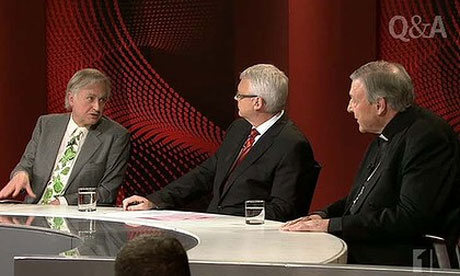Professor Richard Dawkins and Sydney’s Archbishop, Cardinal George Pell, battled it out for an hour on Australian Television.
In a debate that the Sydney Morning Herald says bordered on barely concealed mutual disdain, boiled over more than once and the Science v God, Atheist v Belief, Logic v Faith debate left all parties bruised.
Pell was given the early lead in terms of points by the audience when he highlighted that science could not answer some of life’s most profound questions, such as why we are here.
“The question why is not necessarily a question that deserves to be answered,” Dawkins fired back. “‘What is the purpose of the universe?’ is a silly question.”
Reportedly he however lost points on his understanding of science.
Pell remained constant on gay marriage and his personal perspective on climate change, but seemed to win some unexpected support when he agreed evolution was probably right and that atheists could certainly go to heaven.
The debate highlighted many unanswered questions and the fact that the two would never agree because they were arguing from different premises.
Dawkins is in Australia for the commencement of the Global Atheist Convention, “A Celebration of Reason”, being held in Melbourne. At a “Reason Rally” held in Washington DC in March, as reported in CathNews, Dawkins called for atheists to target and mock religious people.
“Mock them, ridicule them in public. Don’t fall for the convention that we’re all to polite to talk about religion,” Dawkins said.
Speaking independently with “The Australian” Cardinal Pell defended his role in the public life, and by way of example he compared the prominent public role of the Australian Church with the implied public silence in New Zealand.
Saying that people should not be surprised by his involvement in public life, Pell observed that “New Zealanders when they come here (Australia) will often comment on the visibility of the Christian Churches and particularly the Catholic Church, and figures of the Catholic Church in public life.”
Sources
- SMH
- CathNews
- The Australian
- Image: SMH
